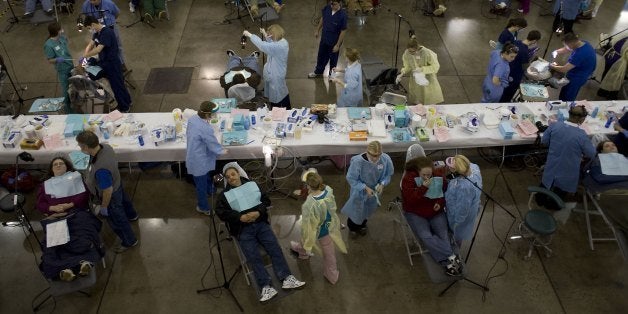
The number of Americans with health insurance held steady in 2012, according to a Census Bureau report issued Tuesday morning. The number of insured Americans should increase significantly in 2014 when Obamacare is expected to cover an estimated 14 million Americans.
The rate of Americans without health insurance declined to 15.4 percent and the number of uninsured people fell slightly to 48 million people in 2012, according to the report. From 2011 to 2012, the number of people who had some form of health coverage grew from to 260.2 million to 263.2 million. The number of uninsured was down by 662,000 last year, not a statistically significant difference from 2011, the census reports.
The health insurance picture is worse for those on the low end of the income scale. Nearly 25 percent of people in households with an annual incomes of less than $25,000 were uninsured last year. In households with incomes of $75,000 or more the uninsured rate was 7.9 percent. These numbers are about the same as in 2011.
The number of uninsured people is expected to sharply decline starting next year, as the major provisions of President Barack Obama's health care reform law take effect. Enrollment into new benefits under Medicaid, the federal-state health program for the poor, and private plans through the law's state-based health insurance exchanges begins Oct. 1 for coverage that will be available as early as Jan. 1.
In the first year of the Obamacare coverage expansion, 14 million people will gain health insurance, the Congressional Budget Office projected in May. By 2023, there will be 25 million fewer Americans without health insurance than if the law had not been enacted, although 31 million will remain uninsured, according to the CBO.
Obama's health care law had little effect on the changing rate of the uninsured between 2011 and 2012, David Johnson, the chief of the Census Bureau's Social, Economic and Housing Statistics Division, said during a conference call with reporters Tuesday. The main drivers of the small reduction in the number of uninsured were more people enrolling in Medicaid or Medicare, the federal health program for the elderly and people with disabilities, he said. More Baby Boomers are reaching 65 and joining Medicare, he said.
Obamacare did have a measurable effect on reducing the number of uninsured from 2010 to 2011, however. A provision of the law allowing young adults under age 26 to remain on their parents' health insurance plans contributed to a decline in the rate of uninsured people aged 19 to 25 from 29.8 percent in 2010 to 27.7 percent in 2011, last year's census report showed. In 2012, that figure declined again to 27.2 percent, a difference the Census Bureau described as not statistically significant.
The number of U.S. residents covered by private health insurance rose from 197.3 million in 2011 to 198.8 million in 2012, a change deemed not statistically significant, and the rate stayed the same at 63.9 percent.
Two million more people were covered by government health programs last year than during 2011 as the total rose to 101.5 million and the percentage increased from 32.2 percent to 32.6 percent, the report says.

Source: U.S. Census Bureau

